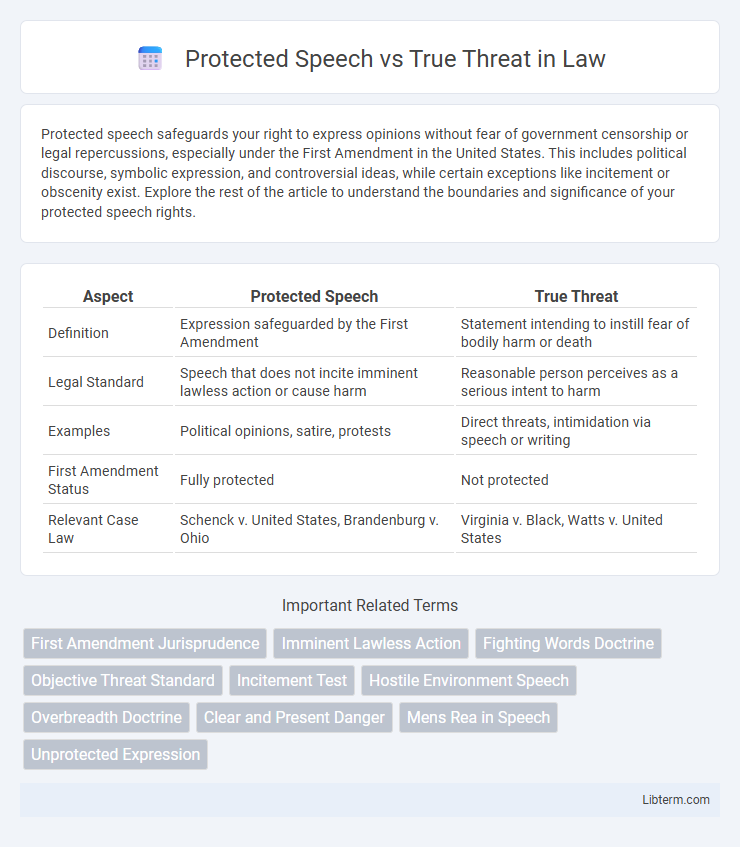Protected speech safeguards your right to express opinions without fear of government censorship or legal repercussions, especially under the First Amendment in the United States. This includes political discourse, symbolic expression, and controversial ideas, while certain exceptions like incitement or obscenity exist. Explore the rest of the article to understand the boundaries and significance of your protected speech rights.
Table of Comparison
| Aspect | Protected Speech | True Threat |
|---|---|---|
| Definition | Expression safeguarded by the First Amendment | Statement intending to instill fear of bodily harm or death |
| Legal Standard | Speech that does not incite imminent lawless action or cause harm | Reasonable person perceives as a serious intent to harm |
| Examples | Political opinions, satire, protests | Direct threats, intimidation via speech or writing |
| First Amendment Status | Fully protected | Not protected |
| Relevant Case Law | Schenck v. United States, Brandenburg v. Ohio | Virginia v. Black, Watts v. United States |
Introduction to Protected Speech and True Threat
Protected speech refers to expressions safeguarded under the First Amendment, including opinions, criticism, and political speech that do not incite imminent lawless action. True threats involve statements intended to intimidate or cause fear of violence, lacking constitutional protection due to their potential to incite harm. Courts differentiate protected speech from true threats by assessing the speaker's intent and the context in which the statement was made.
Defining Protected Speech Under the First Amendment
Protected speech under the First Amendment encompasses expressions, opinions, and symbolic acts that do not incite imminent lawless action or pose a clear and present danger. This protection safeguards political discourse, artistic expression, and controversial viewpoints, ensuring that government censorship is limited. True threats, by contrast, refer to statements meant to communicate a serious intent to commit unlawful violence, which fall outside of First Amendment protection due to their potential to cause fear or immediate harm.
Understanding the Concept of True Threat
True Threat refers to statements where the speaker intends to communicate a serious expression of intent to commit an act of unlawful violence against specific individuals or groups, distinguishing it from protected speech under the First Amendment. Courts analyze the context, intent, and likelihood of actual harm to determine whether speech constitutes a true threat, balancing free speech rights against public safety concerns. Understanding true threat requires examining the subjective intent of the speaker and the reasonable perception of the threat by the listener.
Key Legal Precedents Shaping the Distinction
The landmark case Brandenburg v. Ohio (1969) established the "imminent lawless action" test, distinguishing protected speech from threats not inciting immediate violence. Virginia v. Black (2003) further clarified that true threats are not protected under the First Amendment, emphasizing the speaker's intent to intimidate or cause fear. These rulings have shaped how courts analyze the context and intent behind speech to determine when expressions cross the line into unprotected true threats.
Criteria for Determining a True Threat
Determining a true threat involves assessing whether the statement is a serious expression of intent to commit unlawful violence against a particular individual or group. Courts examine contextual factors such as the speaker's intent, the reaction of a reasonable person, and the specificity and immediacy of the threat. Protected speech, while potentially offensive or disturbing, lacks the clear intent and imminent danger that characterize true threats and therefore remains safeguarded under the First Amendment.
Case Studies: Real-World Examples and Rulings
In landmark cases like *Virginia v. Black* (2003), the Supreme Court differentiated protected speech from true threats, ruling that cross burning with intent to intimidate constitutes a true threat and is not protected under the First Amendment. Similarly, the *Elonis v. United States* (2015) case emphasized the necessity of proving subjective intent behind threatening online posts, highlighting the complex balance between free speech and legitimate threats. These rulings underscore the nuanced legal interpretations that separate constitutionally protected expression from prosecutable threats based on context and intent.
Impact on Freedom of Expression
Protected speech under the First Amendment ensures individuals can express opinions, even if controversial or offensive, fostering democratic discourse and societal progress. True threats, defined as statements meant to intimidate or incite violence, fall outside constitutional protection due to their potential harm and disruption of public safety. Balancing these categories impacts freedom of expression by safeguarding open dialogue while preventing intimidation and harm.
Legal Tests and Analysis Used by Courts
Courts apply the "true threat" legal test to distinguish protected speech under the First Amendment from statements that convey a serious intent to inflict harm, analyzing context, speaker intent, and the likelihood that a reasonable person would perceive the threat as genuine. The Supreme Court's decision in Virginia v. Black established that true threats are not protected, requiring demonstration of intent to intimidate or threaten, rather than mere offensive or hyperbolic language. Lower courts utilize both subjective and objective analysis frameworks, weighing factors such as the defendant's history, the specificity of the threat, and the surrounding circumstances to determine whether the speech crosses the line from protected expression to prosecutable intimidation.
Challenges in Interpreting Speech and Intent
Distinguishing protected speech from true threats presents significant challenges due to the nuanced interpretation of context, tone, and speaker intent. Courts often struggle to balance First Amendment rights with public safety concerns, as subjective perceptions of threatening language can vary widely. This complexity complicates legal standards for determining when speech crosses the line into actionable threats versus constitutionally protected expression.
Conclusion: Navigating Rights and Limitations
Navigating the intersection of protected speech and true threats requires a careful balance that safeguards First Amendment rights while addressing legitimate security concerns. Courts assess context, intent, and the reasonable perception of threat to delineate lawful expression from punishable intimidation. Understanding these legal frameworks helps individuals and authorities uphold free speech without compromising public safety.
Protected Speech Infographic

 libterm.com
libterm.com